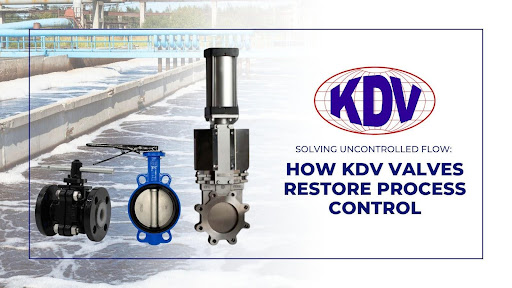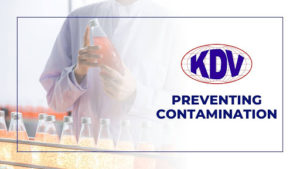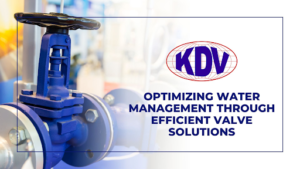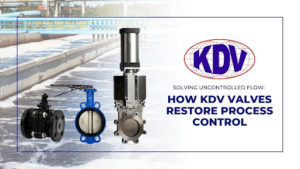Solving Uncontrolled Flow: How KDV Valves Restore Process Control
In industries ranging from chemical plants to water treatment facilities, the ability to precisely control the flow of liquids and gasses is crucial. Uncontrolled flow is a common headache, leading to:
Wasted resources: Over-delivery of fluids means wasted materials and higher costs.
Product quality issues: Inconsistent flow impacts the outcome of manufacturing processes.
Safety risks: Unpredictable flow can create dangerous pressure surges or chemical hazards.

With decades of experience as a leading diaphragm valves manufacturer, we’ve encountered and addressed countless challenges in flow regulation across various industries. Over the years, we’ve seen how unregulated flow can lead to significant problems, from the devastating effects of the Queensland floods in 2010-2011—where inadequate water management exacerbated flooding—to the ongoing water crisis in the Murray-Darling Basin, where unregulated water extraction has caused severe agricultural and environmental damage. Beyond technical specifications, operational efficiency and maintenance costs should also be considered. KDV Valves are designed with easy maintenance in mind, ensuring minimal downtime and long-term performance in demanding environments.
These events underscore the critical importance of precise flow control in preventing disasters and ensuring sustainable operations. KDV Valves are engineered to prevent such issues, offering robust solutions that ensure your systems operate efficiently and reliably
How KDV Valves Help Regulate Flow
Valves function as adjustable gates within a piping system, controlling flow rates by opening or closing to achieve the desired outcome. Understanding the diaphragm valve working principle is essential for appreciating how KDV Valves excel in providing precise flow control and reliability across various applications. KDV Valves are renowned for their:
- Durability: Constructed with robust materials, KDV Valves are designed to last, even in harsh conditions.
- Material Options: Available in a variety of metals and lining materials to ensure chemical compatibility with different fluids.
- Precision Control: KDV valves are engineered for fine adjustments, allowing precise control over flow rates.
- Customisation: KDV, as a leading diaphragm valves manufacturer, offers the ability to tailor valves to meet specific application needs.
In industries such as chemical processing, pharmaceuticals, and water treatment, even small deviations in flow can compromise efficiency and product quality. KDV Valves address these concerns by offering solutions that meet industry-specific requirements, including compliance with Australian and international standards.
Types of KDV Valves for Optimal Control
KDV offers various valve types, each suited to different applications:
Ball Valves: These valves feature a rotating ball with a central hole. Turning the handle allows quick, full open/close control, making them ideal for on/off applications where rapid shutoff is needed.
Diaphragm Valves: Diaphragm valves operate by using a flexible diaphragm that presses against a seat or weir to control flow. Their working principle involves fluid isolation, which makes them excel in handling corrosive or abrasive substances. This design also prevents the fluid from coming into contact with the valve’s moving parts, reducing the risk of contamination and wear.
Butterfly Valves: These valves employ a rotating disc within the flow path. Their compact, lightweight design and large capacity make them perfect for high-volume flow situations where some pressure drop is acceptable.
For critical process industries, the choice between these valve types depends on factors such as media compatibility, required flow regulation, and maintenance considerations. While ball valves provide quick shutoff, diaphragm valves offer superior contamination control, making them indispensable in industries like food production and pharmaceuticals.
Selecting the Right KDV Valve
Choosing the correct valve is crucial for ensuring efficient and reliable system performance in any industrial process. By carefully considering the following key factors, you can select a KDV valve that perfectly meets the specific demands of your application:
- Process Fluid: It’s essential to ensure the valve’s materials are compatible with the specific liquids or gases being controlled. Checking chemical compatibility charts will help you avoid corrosion and material degradation over time.
- Temperature and Pressure: Verify that the valve can withstand the operational environment where it will be installed. This includes handling both the temperature and pressure conditions it will be exposed to during use.
- Flow Characteristics: Determine whether your application requires throttling (gradual control) or simple on/off functionality. Also, consider the tightness of the shutoff required for your process.
- Size and Connections: Make sure the valve matches your pipe size and that the connection type is compatible with your existing system.
Beyond technical specifications, operational efficiency and maintenance costs should also be considered. KDV Valves are designed with easy maintenance in mind, ensuring minimal downtime and long-term performance in demanding environments.
Frequently Asked Questions (FAQs)
1. How do KDV Valves prevent uncontrolled flow in high-pressure systems?
KDV Valves are engineered with precision control mechanisms that regulate flow rates, ensuring stable and predictable operation even under high-pressure conditions. Their robust construction, including diaphragm and butterfly valve options, minimises pressure surges and maintains system stability, preventing flow-related disruptions.
2. What factors should be considered when selecting a KDV valve for flow control automation?
When automating flow control, key factors include the valve’s response time, actuation method (pneumatic, electric, or manual), material compatibility with process fluids, and integration with control systems. KDV Valves are available with automated actuation options, ensuring seamless integration into industrial process control networks.
3. How do KDV Diaphragm Valves improve process control in corrosive or abrasive fluid applications?
KDV Diaphragm Valves utilise a flexible diaphragm that isolates the process fluid from moving parts, reducing wear and contamination risks. This makes them particularly effective in handling corrosive chemicals, slurries, and other challenging media while maintaining precise control over flow rates.
4. What are the maintenance requirements for ensuring KDV Valves maintain optimal flow control performance?
Regular inspection of seals, diaphragms, and actuators helps ensure consistent performance. KDV Valves are designed for easy maintenance, with accessible components and long-lasting materials that reduce the frequency of replacements and system downtime.
5. How do KDV Valves contribute to energy efficiency and cost reduction in industrial flow control?
By providing precise modulation of flow rates, KDV Valves help reduce energy consumption associated with pumping systems. Proper flow control minimises waste, extends equipment lifespan, and enhances overall process efficiency, leading to lower operational costs in industries such as water treatment, chemical processing, and food production.
Addressing uncontrolled flow begins with selecting the right valve. When these factors are taken into account—especially material compatibility, temperature, and pressure ratings—you significantly reduce the risk of issues like corrosion, leakage, and inefficient flow control.
If uncontrolled flow is disrupting your operations, don’t hesitate to contact KDV. Our expert team is ready to help you select the perfect valve solution, tailored to your specific needs, ensuring that your system operates smoothly and efficiently.


